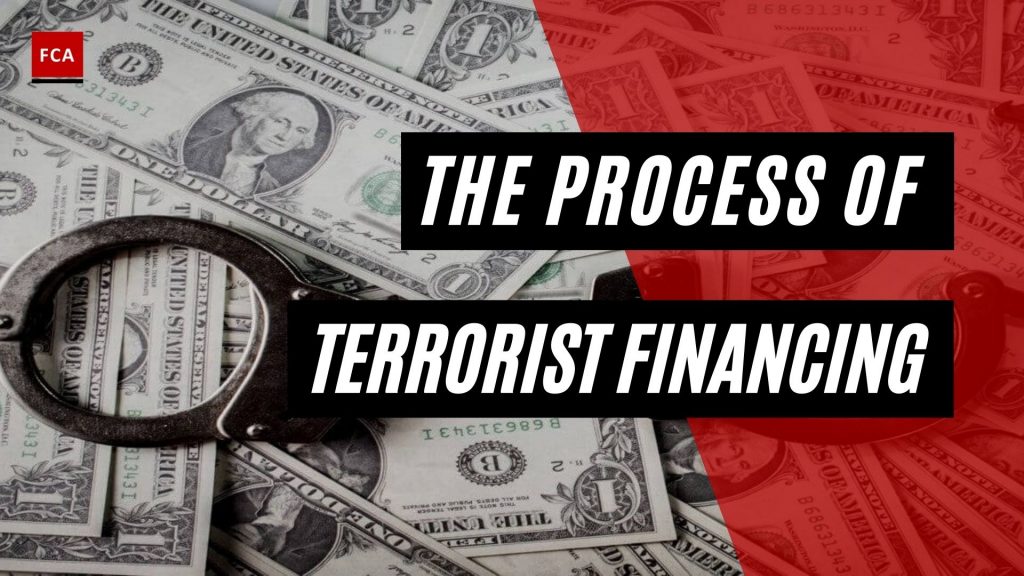The process of terrorist financing. Terrorists and terror organizations have long threatened our lives. Terrorists and terror organizations threaten the security, infrastructure, citizens and communities worldwide. It is estimated that terrorists kill an average of 21,000 people worldwide each year. Having said this, terrorism tends to be very geographically-focused: 95% of deaths in 2017 occurred in the Middle East, Africa or South Asia.

The Process Of Terrorist Financing
Terrorist organizations require significant funding for the undertaking of terrorist acts, but also for maintaining the functioning of the organization, to provide for its basic technical necessities, as well as to cover costs related to the spreading of their ideologies.
According to FATF, “terrorism financing is the provision of funds for the act of terrorism to terrorists or terrorist organizations”.
Terrorist groups range in size from big, state-like entities to smaller, dispersed parties. Individuals who received inspiration in radicalized surroundings or via self-radicalization have also conducted terrorist actions. These “lone actors” also need financing for their operations. They take control of the entire process from financing to implementation of action themselves.
Hereby, the costs for terrorist attacks vary significantly. For instance, the estimated cost of the 1993 World Trade Center bombing was $19,000. The cost of the Bali bombing in 2002 was $20,000. The September 11 assaults were comparatively pricey as their cost was between $350,000 and $500,000, but they used at least nine hijackers from abroad and required multiple costly flight simulation training sessions.
Terrorist organizations require funds for their training programs and to provide food and shelter for their members. They also need to get hold of equipment that is used to conduct terrorist attacks, including weapons such as guns and rifles, triggers, explosives, and communication devices such as mobile phones. Typically, a larger sum of money is also spent on fake documentation like passports. Terrorist may also need funds to bribe government officials and other parties.
The Sequence Of The Terrorist Financing Process
Typically, the process of terrorist financing follows a certain sequence. Simply put, the process of terrorist financing follows a four-stage approach. These four stages are collecting, storing, moving, and using.
Stages 1 – Collecting
The first stage, the collecting stage, refers to the generation of the funds intended for a terrorist or terror organization. The funds can originate from a variety of sources. Typical sources of financial support for terrorist financing include direct donations by individuals and organizations; the use of charities and non-profit organizations; and from something that might already be obvious to you, which is criminal activity. But terrorist can also generate funds from legal business operations.
Stage 2 – Storing
The second stage is the storing stage. To understand this, put yourself in the shoes of a fundraiser of a terrorist organization for a moment. You have received some money from direct donations in amounts large and small, given by individuals, legal entities, non-profit organizations, or businesses, and, in some cases, foreign countries. What do you do with this? You bundle it to make it easier to handle and you store it somewhere.
The storing of funds can be accomplished through means such as: Bank and other accounts, pre-paid cards, high value commodities such as oil, art and antiquities, agricultural products, and precious metals and gems, and even used vehicles. Terrorist organizations even store the funds in the form of Cryptocurrencies and simply keep it in cash. They are storing the funds until they have determined and planned for their use.
Stage 3 – Moving
The third stage is moving the funds. When the terror group has as much funds as required and an operational need, they move to funds from the store to somewhere else. The choice of movement mechanism naturally relates to the store. Well-known mechanisms for moving values include the traditional banking and financial sector, money services businesses, the Hawala financial system, they smuggle it in the form of cash, gold or other, or if they have it in cryptocurrencies, they transfer them to another wallet. It’s like in other crimes, moving the body has the highest risk profile and so it is during the moving stage that terrorists are most vulnerable, especially to with regards to international economic sanctions.
Stage 4 – Using
The last stage of terrorist financing is using the funds. There are countless examples of what for terrorist can use their funds. Some more examples of the use of funds in terrorism include using it for the terrorist organization itself to pay for weapons, material, equipment, overheads, media and messaging, training, and salaries. The funds can also be used to pay for foreign fighters and organize travel services or to cover passport and visa costs. Some of the forms of usage are also day-to-day expenses which are difficult to identify as terrorism related.
The Definition Of Terrorist Financing
The processing of funds to sponsor or facilitate terrorist activity is referred to as terrorist financing. A terrorist organization constructs and maintains an infrastructure to facilitate the development of sources of funding for their own needs and, potentially, to launder funds used in terrorist activity.
Terrorist organizations obtain funding from a variety of sources, frequently combining both legal and illegal funding, which can be divided into two categories:
- Donations, community solicitation, and other fund-raising initiatives are examples of financial support. Financial assistance may be provided by states, large organizations, or individuals.
- Income from criminal activities such as kidnapping, extortion, smuggling, or fraud is referred to as revenue generating activities. Income can also be generated through legitimate economic activities such as diamond trading or real estate investing.
Terrorist organizations will seek to conceal illegal funds while maintaining or increasing revenue from legitimate sources. Because of the need to conceal the source of funds, terrorist financing shares some similarities with traditional money laundering, specifically the use of the three steps of placing, layering, and integrating funds in the international financial system.
The following is a significant distinction between traditional money laundering and terrorist financing:
- Traditional money laundering involves the investigation of financial transactions in order to link the funds to a previously committed criminal act and to deprive the criminal and any accomplices of the economic benefits of engaging in criminal behavior.
- Terrorist financing investigations are conducted to prevent individuals from gaining access to funds that could be used to fund future criminal activity.
Terrorist financing is defined as the provision, collection, or receipt of funds with the intent or knowledge that the funds will be used to carry out a terrorist act or any other act intended to cause death or serious bodily harm. It also includes collecting or receiving funds with the intent or knowledge that they will be used to benefit a terrorist group. The Criminal Justice (Terrorist Offences) Act of 2005 implemented the 1999 United Nations Convention to Combat the Financing of Terrorism.
Final Thoughts
Terrorists use a variety of methods to finance their activities and conceal the sources of their funds, so financial regulators and law enforcement must employ a variety of methods to apprehend these criminals.
The funds may come from legal sources such as legitimate businesses, government funding, and religious or cultural organizations, or they may come from illegal sources such as drug trafficking, kidnapping, and government corruption. Through money laundering, funds may also come from an illegal source but appear to come from a legal source.








